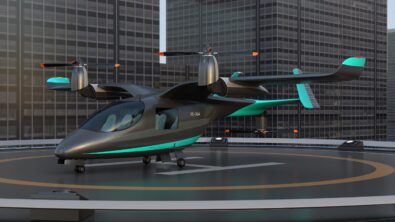Building George Jetson’s Car Part Two – Summary

Advanced air mobility (AAM) is a new classification of aircraft being developed that can offer a new form of short-range aerial transport. Whether acting as air taxis for passengers or hauling cargo, these new vehicles can transform transportation within and between cities by bypassing all sorts of ground traffic. Naturally, there are a number of challenges companies working in AAM will need to navigate before releasing their fleets into the sky.
The Talking Aerospace Today podcast has begun a new arc to identify these challenges and explore what companies need to consider in their AAM developments to overcome them. In this latest episode, Todd Tuthill, Vice President of Aerospace and Defense (A&D) for Siemens Digital Industries Software, continues his introduction to AAM, its major obstacles, and the role of digital transformation in assisting companies working in AAM.
The largest challenges in AAM development
To provide context, the four key challenges AAM companies would face were reiterated by Todd. Those four challenges include:
- Autonomy: Some companies have plans to make their AAM vehicles autonomous down the line, or even from the very beginning. There will be many obstacles in operating such vehicles, as well as cultural acceptance.
- Batteries: While battery technology has come a long way in recent years, applying them to aircraft is still complex. Engineers will need to balance power-density, weight, and range to make the optimal AAM vehicle.
- Infrastructure: Cities currently lack the vertiports and infrastructure to support AAM fleets. How will vehicles be powered, and will the sources of that power be sustainable?
- Certification: As a new classification of aircraft, certifying AAM vehicles with the FAA will present new roadblocks and quandaries to ensure safe release. This is doubly so if vehicles are made to be autonomous.
All these challenges are certainly solvable, yet each will have their own difficulties.
The role of digital transformation
According to Todd, digital transformation can play a significant role in getting over these difficulties. In fact, digital transformation has already been assisting the A&D industry for years, optimizing engineering processes to ensure aircraft are safe to operate while being brought to market as quick as possible. The aircraft may be different from AAM vehicles, but the laws of physics remain the same, and so do the tools that rely on them.
There are a variety of software tools out there to help in this regard. Leveraging the digital twin, for example, allows a company to create a virtual representation of a product or process before creating it physically. Engineers can then simulate the digital twin to see how that product or process behaves virtually and use the results to improve its functions. These methodologies can be used to optimize everything from an AAM vehicle’s propulsion systems to how much energy a vertiport consumes to power air taxies.
Digital transformation for startups
That said, digital transformation is likely to look different for startup companies, which make up a large number of the companies currently working in AAM. For one, being brand new companies backed by business ventures, startups are under more pressure to get their products out to market faster and establish a name for themselves. Digital transformation can help accelerate engineering processes and ensure those returns on investments.
Fortunately, startups also have an advantage that can aid their digital transformations. Unlike companies that have been around for a longer time, startups have little to no data in need of digitalization in the first place. This would allow them to get on with their digital transformation journeys even faster, boosting the prospects of getting their AAM vehicles into their air in their desired timeframes.
Toward the rise of AAM
The challenges in develop advanced air mobility may seem daunting to some, but they are not impossible. Bolstered by digital transformation, companies can find ways to overcome them and bring AAM vehicles from the realm of imagination into reality.
Stay tuned for future episodes of Talking Aerospace Today, which will go over each challenge described above in more detail.
Siemens Digital Industries Software helps organizations of all sizes digitally transform using software, hardware and services from the Siemens Xcelerator business platform. Siemens’ software and the comprehensive digital twin enable companies to optimize their design, engineering and manufacturing processes to turn today’s ideas into the sustainable products of the future. From chips to entire systems, from product to process, across all industries. Siemens Digital Industries Software – Accelerating transformation.


